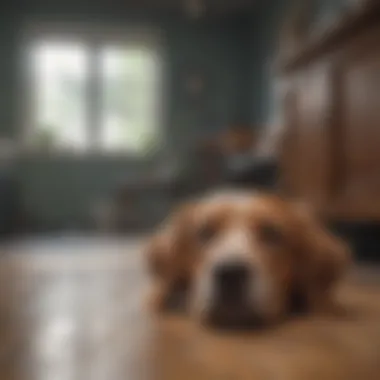Effective Methods for Cleaning Dog Urine: A Comprehensive Guide


Intro
Cleaning dog urine is more than an occasional chore—it’s a necessary aspect of maintaining a healthy and enjoyable living environment. Understanding effective methods to tackle this issue can prevent long-term damage to your home and ensure the well-being of your dog. This guide delves into practical techniques, addresses the science behind odor removal, and emphasizes the importance of choosing safe cleaning products.
Fascinating Facts About Dogs
Unique Characteristics
Dogs, scientifically known as Canis lupus familiaris, exhibit remarkable traits that distinguish them from other domesticated animals. They possess an acute sense of smell, which is estimated to be between 10,000 to 100,000 times more sensitive than humans. This invites an exploration into their behavior around urination, as scent plays a pivotal role in their communication and territorial marking.
Extraordinary Abilities
Notably, some dog breeds have specialized skills. For instance, Bloodhounds are adept scent-tracking animals, making them invaluable in search-and-rescue operations. These abilities also explain why dog urine may pose challenges for odor elimination. Understanding these characteristics assists owners in managing their pets more effectively and addressing issues related to cleanliness.
Importance of Urine Cleaning
Cleaning dog urine promptly can prevent permanent stains and lingering odors. Left unattended, urine can seep into carpets, woods, and other porous materials, leading to costly damage. Moreover, specific cleaning agents can contribute to a safer environment for both pets and humans, reducing the risk of exposure to harmful chemicals.
Understanding Dog Urine
Understanding dog urine is crucial for pet owners and caregivers. It offers insights into not only the cleaning process but also how to prevent those messes in the first place. Gaining knowledge about the urine itself can lead to more effective and informed actions when addressing accidents. There are several aspects that merit attention, from its composition to the behaviors that lead to indoor urination.
Composition of Dog Urine
Dog urine primarily consists of water, urea, uric acid, and a variety of ions. This composition plays a significant role in the odor and staining properties of urine. Urea accounts for a large part of the nitrogen in the waste, while uric acid is largely responsible for the lingering smell. When cleaning, it is crucial to understand that merely wiping the surface will not eliminate odors, as the uric acid can become deeply embedded into porous materials like carpets and upholstery.
Furthermore, dog urine contains substances that can vary in concentration based on the dog's diet, health, and hydration levels. As a result, the odor strength and cleaning requirements can differ significantly. Therefore, knowing what is in the urine helps in choosing the proper cleaning techniques and products.
Why Dogs Urinate Indoors
Several factors can contribute to dogs urinating indoors, and understanding these can help in addressing the behavior effectively. One common reason is lack of proper house training. Puppies especially need consistent training to associate the outdoors with toilet needs. However, it is not always an issue of training. Health problems, such as urinary tract infections, can cause increased urgency or frequency of urination. Additionally, stress or anxiety may lead a dog to seek comfort indoors, leading to accidents.
This means that before rushing to clean an accident, it is essential to evaluate the underlying reasons. Knowing why a dog has urinated indoors aids in implementing long-term solutions that can decrease the likelihood of future incidents, thus fostering a cleaner environment. Identifying a dog's needs effectively sets the stage for more hassle-free living with a pet.
Immediate Response to Urine Accidents
Immediate response to dog urine accidents is not just about cleaning the mess. It plays a crucial role in maintaining hygiene, preventing long-term damage to your home, and enhancing your dog's well-being. Timely and effective cleanup minimizes the risk of lingering odors, which can attract your dog back to the same spot.
Recognizing the Accident
Recognizing that an accident has occurred is the first step in the response process. Dogs may exhibit various signs, such as lingering near a certain area, sniffing, or displaying signs of discomfort. If you are attentive and observe these cues, you can handle the situation promptly. Sometimes, you may hear the sound of urine hitting the floor. Often, you'll notice a wet patch on your floor or carpet after the event.
Once you identify an accident, move swiftly. The longer urine sits on surfaces, the more difficult it becomes to clean and deodorize. Early recognition allows you to initiate the cleaning process before the mess seeps deeper into fabrics or porous surfaces.
The Importance of Quick Action
Quick action is vital. When dog urine sits, it penetrates materials and creates stubborn stains and odors. If left untreated, this can lead to permanent damage and health risks due to bacterial growth. By ensuring an immediate response, you can significantly improve the outcome of the cleaning process.
- Minimizing Stains: Urine can cause discoloration on floors and fabrics. Fast action helps decrease the risk of complex cleaning procedures later.
- Preventing Odors: Urine contains ammonia and other compounds that can linger if not cleaned. Strong odors may become embedded in carpets and furniture.
- Promoting Good Behavior: Quick cleaning teaches dogs that the area is not a bathroom space. The absence of lingering scents discourages them from returning to the same spot.
- Health Considerations: Long exposure to urine can pose risks for both pets and humans. An immediate response contributes to a healthier living environment.
The first step in effective cleaning is proper recognition of the accident. Awareness can guide a simple response to a more complicated problem in the future.
Tools and Materials for Cleaning
Understanding the right tools and materials is essential for effective cleaning of dog urine. The quality of cleaning products and tools significantly affects the success of odor elimination and stain removal. Certain tools and products not only aid in the immediate recovery from accidents but also help in preventing future incidents. With the right approach, pet owners can maintain a fresh environment and ensure their dogs remain happy and healthy.
Essential Cleaning Tools
When cleaning up dog urine, certain tools are indispensable. Here are some key items:
- Absorbent Cloths or Towels: These are first responders to any urine accidents. They soak up liquid quickly, reducing the extent of stains and odors.
- Mop and Bucket: For larger areas, a mop helps in cleaning floors effectively. A bucket can hold cleaning solutions for mopping.
- Vacuum Cleaner: A vacuum cleaner with a proper attachment is useful for removing dried urine stains from carpets and fabrics.
- Spray Bottles: These enable targeted cleaning with liquids, allowing you to apply enzymatic solutions or other cleaners precisely.


These tools each serve vital functions in managing urine incidents. The right combination ensures efficient cleanup and improved hygiene in the home.
Choosing the Right Cleaning Products
Selecting appropriate cleaning products is crucial for effectively removing dog urine. The options can be categorized into three distinct types: natural cleaners, commercial products, and enzymatic cleaners.
Natural Cleaners
Natural cleaners are derived from organic materials, making them an attractive option for pet owners concerned about chemical exposure. They typically include ingredients like vinegar or baking soda. Their key characteristic is that they are safe for both pets and humans. This consideration is especially vital in homes with children or sensitive animals.
Natural cleaners often provide several benefits. They are non-toxic and environmentally friendly. However, one disadvantage is that they may not be as powerful in breaking down stains and odors compared to commercial options. Pet owners might find it necessary to use more elbow grease with these products to achieve the desired results.
Commercial Products
Commercial products like Fabuloso or Zep are readily available and often marketed specifically for pet messes. A primary feature of these products is their convenience; they can be found in many stores. Their effectiveness is usually higher than that of natural cleaners, particularly on tough stains.
However, they contain synthetic chemicals that can pose risks to pet safety. Furthermore, some dogs may have allergies to the ingredients, which can lead to adverse reactions. Therefore, it is crucial to read labels and choose products that are designed for safe use around pets.
Enzymatic Cleaners
Enzymatic cleaners, such as Nature's Miracle, specifically target organic stains like urine. They work by breaking down the components of the urine at the molecular level. This ability is their strongest advantage, making them an effective choice when it comes to odor elimination and stain removal.
Their unique feature lies in their formulation. These cleaners contain live enzymes that digest the organic materials in stains. This process makes them particularly beneficial for removing persistent odors left behind by urine. The drawback here is often their price point, which can be higher than other types of cleaners. However, many pet owners find that the effectiveness justifies the cost.
In summary, the choice of cleaning products is significant for addressing dog urine incidents. By understanding the specific characteristics and uses of natural cleaners, commercial products, and enzymatic cleaners, pet owners can optimize their cleaning routines for better results.
Step-by-Step Cleaning Method
A systematic approach to cleaning dog urine is crucial. The methods utilized directly impact the success of odor removal and stain elimination. By understanding the step-by-step cleaning process, pet owners can effectively manage accidents and maintain a clean environment. This section outlines practical steps to ensure that every incident is handled properly, minimizing the chances of recurrence.
Initial Blotting Technique
The first crucial action after a urine accident is to blot the area. This technique involves using paper towels or a clean cloth to absorb as much liquid as possible. By applying firm pressure, pet owners can remove a significant amount of urine before it seeps deeper into the flooring or carpet. Failing to blot promptly can lead to deeper stains and odors, making the overall cleaning process more challenging.
- Act Quickly: Time is critical. The quicker you respond, the better the chance of removing the stain entirely.
- Use Absorbent Material: Ensure that the cloth or towels used are absorbent enough to soak up as much liquid as possible.
- Blot, Don’t Rub: Rubbing may spread the urine and embed it deeper into the fibers. Always blot gently.
Cleaning with Enzymatic Solutions
After initial blotting, the next step involves utilizing enzymatic cleaners. These products contain enzymes that break down the components of dog urine, effectively eliminating odors and stains. Unlike conventional cleaners, which may mask the odor, enzymatic solutions address the root cause.
- Selection of Cleaner: Choose a high-quality enzymatic cleaner, specifically formulated for pet stains. These can effectively neutralize odors.
- Application: Apply the cleaner generously to the affected area, ensuring it penetrates the fibers and underlying materials. Follow the manufacturer's instructions for optimal results.
- Allowing Adequate Time: Let the cleaner sit for the recommended duration to maximize its effectiveness on stubborn stains. Often, this may range from 10 to 30 minutes.
Final Rinsing and Drying
Once cleaning is complete, rinsing and drying are essential steps. Rinsing the area helps remove any residue from the cleaning products used and aids in preventing any sticky or discolored spots in the future.
- Rinse the Area: After the enzymatic cleaner has had time to work, lightly rinse the area with clean water. Use a damp cloth to help lift any remaining cleaner residue.
- Thorough Drying: Proper drying prevents any moisture retention, which could lead to mold growth or continued odor issues. Use fans or a ventilation method to dry the vicinity quickly.
Important Note: Always test any cleaning products on an inconspicuous area to ensure compatibility with your flooring or carpet type.
By following these steps diligently, pet owners can significantly enhance their cleaning efforts, leading to a fresher and cleaner home. With a structured cleaning method, both immediate and long-term cleanliness can be achieved.
Preventing Future Accidents
Preventing future accidents is a crucial aspect of maintaining a clean home and ensuring the well-being of both dogs and their owners. Effective prevention requires understanding canine behavior and implementing appropriate strategies. By investing time in proper training and addressing any behavioral issues, pet owners can significantly reduce the frequency of indoor urination. This not only helps in keeping the environment clean but also fosters a better relationship between the pet and owner.
Proper House Training
House training is fundamental. It establishes good habits early on. For puppies, consistent reinforcement and patience are key. Setting a schedule for potty breaks can be effective. Take the dog outside frequently, especially after meals or naps. Use positive reinforcement techniques, such as treats or praise, when the dog urinates outdoors.
It's essential to recognize the dog’s signals. Look for behaviors like circling, sniffing, or whining. Respond promptly when noticed. This helps them associate outdoors with bathroom needs. Consider using a crate for training. Dogs naturally avoid soiling their sleeping area. This can promote bladder control.


Tip: Always be patient. Each dog learns at its own pace, and consistency is critical.
Key Training Techniques:
- Establish a routine to follow.
- Use the same door for exits to form habits.
- Limit access to indoors until trained.
Identifying and Addressing Behavioral Issues
Sometimes, accidents occur due to underlying behavioral issues. Stress is a common factor. Changes in environment—like new pets, relocation, or family dynamics—can trigger elimination problems. Monitoring the dog's behavior is crucial. Note changes in eating or drinking patterns which can impact potty habits.
If accidents happen frequently, consulting with a veterinarian or a professional dog trainer may be beneficial. They can help identify any physical or psychological issues and suggest solutions or tailored training strategies.
Addressing behavioral issues also requires creating a positive environment. Ensuring the dog has ample physical exercise can alleviate anxiety. Extra playtime or walks can reduce stress, thus limiting bathroom accidents indoors.
Important Considerations:
- Monitor stressors in the dog’s surroundings.
- Provide adequate exercise to manage energy levels.
- Consider behavioral training assistance if necessary.
By taking preventive measures through effective training and addressing behavioral issues, pet owners can create a harmonious living environment. This not only enhances cleanliness but also nurtures the dog's overall well-being.
Dealing with Persistent Odors
Dealing with persistent odors is a crucial topic in maintaining a clean and healthy environment for both pets and their owners. Dog urine can leave a lasting smell if not properly addressed. This section provides insights into the sources of these odors and effective strategies for removing them. Understanding persistent odors allows for more effective cleaning and helps prevent future issues, ensuring a more enjoyable living space.
Understanding Odor Sources
The first step in addressing persistent odors is identifying their sources. Dog urine does not just evaporate; it leaves behind compounds that can linger.
- Urea, uric acid, and ammonia are key components in dog urine. When urine dries, the uric acid crystallizes and can be challenging to remove.
- These elements can bond with surfaces, creating enduring odors that casual cleaning cannot eliminate. It is vital to address these sources directly to avoid long-term scent issues.
Also, consider the area where the accident occurred. Carpets, upholstery, and hardwood can all absorb odors differently. The right cleaning method depends on the surface involved.
Advanced Odor Elimination Techniques
To combat persistent odors, more advanced techniques may be necessary. Common methods include the use of odor neutralizers and professional cleaning services.
Odor Neutralizers
Odor neutralizers play a significant role in eliminating persistent smells. They work by chemically binding to odor molecules, which effectively neutralizes the scent rather than just masking it.
One key characteristic of odor neutralizers is their ability to target specific odors. Unlike simple air fresheners, they address the source directly, making them a popular choice for pet owners.
Some unique features of effective odor neutralizers include:
- Non-toxic ingredients: This ensures safety for pets and children, making them a recommended choice when cleaning.
- Versatility: They can often be used on various surfaces, from fabrics to hard floors, which provides convenience for owners.
However, not all odor neutralizers are equal. Some may require repeated applications or may not work as effectively on certain surfaces, which can be seen as disadvantages.
Professional Cleaning Services
For persistent odors that do not respond well to home remedies, professional cleaning services can be a practical solution. These services are valuable for deep cleaning and odor elimination, utilizing specialized equipment and techniques.
The key characteristic of professional cleaning services is their expertise. Trained professionals understand the best ways to deal with stubborn odors, increasing the odds of complete odor removal.
Unique benefits of these services include:
- Advanced equipment: Many services use steam cleaners or chemical treatments that may not be available for home use.
- Time-saving: Owners may lack the time or energy for thorough cleaning, making professional help an attractive option.
Nonetheless, costs can be a consideration. Professional services might be more expensive, and finding a trustworthy provider is essential. Evaluating their methods and customer reviews can help ensure a good decision.
Addressing persistent odors in a timely manner is essential not only for comfort but also for the well-being of pets in the home.


Evaluating Cleaning Products
When it comes to cleaning dog urine, selecting the right cleaning product plays a crucial role. The effectiveness and safety of these cleaners are paramount, especially considering their impact on both pets and the home environment. This section aims to delve into the different categories of cleaning products, articulate their benefits, and discuss critical considerations for effective usage. Understanding how to properly evaluate these products can lead to better outcomes in maintaining a clean and healthy living space for both an owner and their dog.
Effectiveness of Natural vs.
Commercial Cleaners
Choosing between natural and commercial cleaners requires careful thought. Natural cleaners, such as vinegar, baking soda, and essential oils, are often praised for their eco-friendliness. They may offer satisfactory results in neutralizing odors without exposing pets and humans to harsh chemicals. Moreover, they are often more affordable and readily available at home.
Conversely, commercial cleaners boast advanced formulas designed specifically for pet stains. These products can incorporate enzymes that effectively break down the compounds in urine, ensuring proper odor removal. Brands such as Nature's Miracle, Simple Solution, and PetSafe produce items that show high efficacy in eliminating urine stains. However, one must be vigilant about the ingredients, as some commercial options may contain substances that are harmful to pets.
To make an informed choice, consider the surrounding factors, such as the severity of mess, availability of products, and potential allergic reactions in pets. Testing on a small area before full application can prevent further issues.
Safety Considerations for Pets
Maintaining a clean environment should never compromise the safety of pets. When evaluating cleaning products, it is essential to be cautious about the ingredients used. Some common household cleaners can be toxic to animals. For example, products containing ammonia can not only fail to neutralize dog urine effectively but can also cause respiratory issues for pets. Additionally, certain commercial cleaning products can lead to skin irritations or poisoning.
Here is a brief list of safety considerations to keep in mind:
- Read Labels Carefully: Check for warnings or ingredients that are harmful to dogs.
- Choose Pet-Safe Options: Opt for cleaners certified as safe for use around animals.
- Ventilation: Ensure good airflow in the area being cleaned to minimize potential inhalation of harmful chemicals.
- Store Cleaners Safely: Keep cleaning products out of the reach of pets to prevent accidental ingestion.
Always place the well-being of your pets first when selecting and using cleaning products.
In summary, evaluating cleaning products when addressing dog urine is a vital aspect in the cleaning process. By weighing the effectiveness of natural versus commercial cleaners and considering the safety of ingredients, one can foster a healthier home environment, protecting both pets and their owners.
Maintaining a Clean Environment
Maintaining a clean environment is crucial when it comes to sharing your home with a dog. Frequent cleaning not only improves the aesthetic appeal of your living space, but it also enhances the overall well-being of your pet. A clean environment can reduce the risk of health issues for both pets and humans. When dog urine is left unaddressed, it can lead to lingering odors and bacteria, which should be avoided. Conscious effort in cleaning routines can create a positive atmosphere for both the dog and the family.
Regular Cleaning Routines
Establishing regular cleaning routines can be a significant step toward maintaining a clean environment. This means scheduling specific times for cleaning, which includes immediate response to urine accidents as well as routine deep cleaning of carpets and floors.
- Frequency: Aim for daily spot cleaning, especially in areas where your dog frequently spends time. Weekly deep cleaning sessions should also be a part of your plan.
- Areas to Focus On: Pay special attention to carpets, furniture, and any surfaces where your dog may have accidents.
- Product Selection: Choose appropriate cleaning agents. For routine cleaning, using mild detergents or enzymatic cleaners helps break down odors effectively.
This systematic approach allows for the immediate addressing of messes while also preventing buildup over time. The benefits are clear: you create an inviting space that can strengthen the bond between you and your pet.
Evaluating Home Layout for Pet Safety
The layout of your home plays an important role in maintaining a clean atmosphere. By evaluating and adjusting the space, you can minimize accidents and make cleaning more efficient.
- Define Dog-Free Zones: Consider designating specific areas that will remain dog-free. This minimizes the potential for accidents in your main living areas.
- Accessible Cleaning Supplies: Make sure cleaning supplies are easily accessible for prompt action if accidents do occur.
- Flooring Choices: Opt for flooring materials that are easier to clean. For instance, laminate or tile floors are usually more resistant to stains than carpets.
These strategic adjustments not only keep the environment clean but also promote safety for your pet. By thinking ahead about the layout, you help prevent future incidents and ensure that cleaning becomes a task that is manageable and timely.
A clean home is a happier home for both humans and their canine companions.
Final Thoughts
Cleaning dog urine is not just about maintaining a tidy home; it has implications for health, safety, and the emotional well-being of both pets and their owners. This article summarized several aspects, from immediate responses to cleaning techniques and preventive measures. Understanding these elements is crucial for creating a livable environment where both pets and humans can thrive.
Long-Term Considerations
Maintaining a clean space after a dog urine incident is an ongoing commitment. A few key long-term considerations include:
- Consistent Training: Ongoing training can reduce the frequency of indoor accidents. Regular reinforcement helps dogs associate outdoor locations with relief.
- Regular Cleaning: Establishing a consistent cleaning routine helps to keep odors at bay. Regularly cleaning surfaces where the dog wanders is crucial for healthy living.
- Behavioral Monitoring: Pay attention to any signs that may indicate underlying health issues, which could contribute to inappropriate urination. For instance, frequent accidents may necessitate a visit to the veterinarian.
- Product Storage: Proper storage of cleaning products ensures that pets do not accidentally ingest harmful substances. Always read labels and take note of safety warnings.
These elements enhance the pet's quality of life and prevent problems that could arise from neglecting cleanliness in the home environment.
Resources for Further Information
For those looking to expand their understanding of effective cleaning methods and responsible pet ownership, consider referencing:
- Wikipedia on Pet Care for general guidelines and tips.
- Britannica for articles on companion animals and caring for them.
- Online communities, such as Reddit where pet owners share experiences and solutions.
- Parenting groups on platforms like Facebook that discuss issues related to pet care and child safety.
By engaging with these resources, readers can reinforce their knowledge and find community solutions to common challenges in pet ownership.







